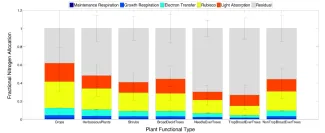Nitrogen (N) is one of the most important nutrients for plant growth and a major constituent of proteins that regulate photosynthetic and respiratory processes. Motivated by the strong N limitations in high-latitude systems, we developed (Ghimire et al. 2017) a comprehensive analysis of N allocation in leaves for major processes and a wide range of plant functional types (PFTs). Using a wide range of observations, we determined PFT-specific allocation patterns of leaf N for photosynthesis (Rubisco, electron transport, light absorption) and respiration (growth and maintenance), and an unexplained “residual” N pool. Based on our analysis, crops partition the largest fraction of N to photosynthesis (57%) and respiration (5%) followed by herbaceous plants (44% and 4%). Tropical broadleaf evergreen trees partition the least to photosynthesis (25%) and respiration (2%) followed by needleleaf evergreen trees (28% and 3%). In trees (especially needleleaf evergreen and tropical broadleaf evergreen trees) a large fraction (70% and 73% respectively) of N was not explained by photosynthetic or respiratory functions. This large residual pool is hypothesized to emerge from larger investments in cell wall proteins, lipids, amino acids, nucleic acid, CO2 fixation proteins (other than Rubisco), secondary compounds, and other proteins. The resulting pattern of N allocation provides insights on mechanisms that operate at a cellular scale within leaves, and can be integrated with ecosystem models to derive emergent properties of ecosystem productivity at local, regional, and global scales.
For more information, please contact:
William Riley
wjriley@lbl.gov

